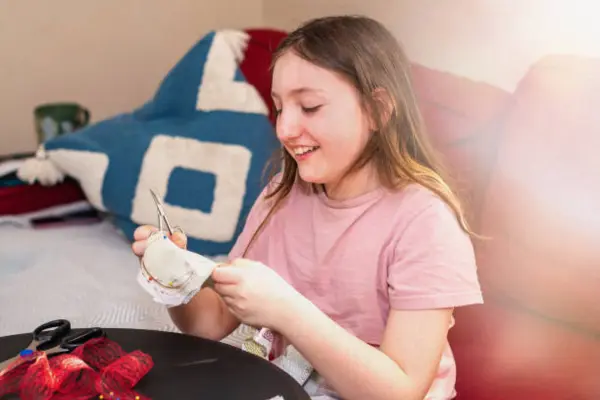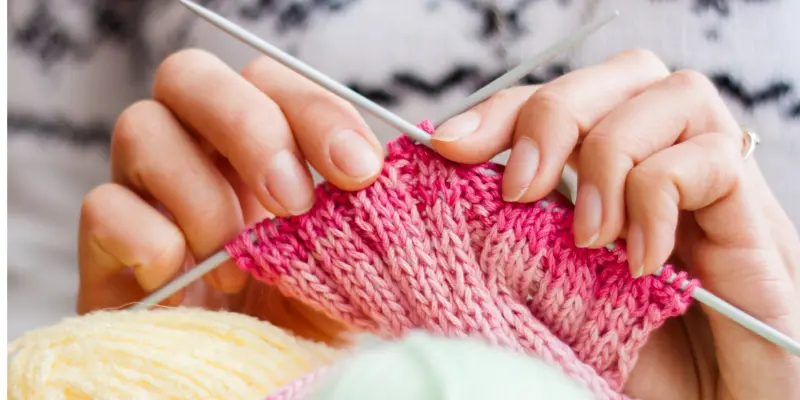Stitch Markers: Tiny Tools, Big Impact on Your Knitting Projects
Updated: 1 Jul 2025
98
Functionality matters, but your knitting bags should also showcase your personal style. While yarn and needles often take the spotlight, it is the small accessories, such as knitting stitch markers, that silently transform the entire process.
These tiny tools can make a significant difference, especially when managing complex patterns or tracking repetitive rows. Whether you are new to knitting or have years of experience, knowing how to use knitting stitch markers can greatly enhance your projects.
Alongside other essentials, such as knitting bags, these tools help keep your knitting experience organized and stress-free.
What are knitting stitch markers?
Knitting stitch markers are small rings or clips used to mark specific points on your needle or within your fabric. Stitch markers are available in plastic, metal, or decorative beaded styles, and come in both fixed and removable options.

Fixed markers slip over the needle, while removable ones can be clipped directly into the yarn. These markers serve a wide variety of purposes, from marking the beginning of a round to identifying stitch increases or decreases in lace and cable patterns.
Why stitch markers matter
Here are the reasons why the stitch makers matter:
1. Precision in pattern tracking
When working on patterns that involve repeats or intricate shaping, knitting stitch markers act as reliable guides. They allow you to divide your work into sections, ensuring that each segment of the pattern remains accurate. This helps prevent errors and saves time by reducing the need to unravel your work.
2. Better project organization
Using knitting stitch markers helps you stay in control of your progress. Whether you are knitting a sweater, shawl, or hat, placing markers at strategic points helps track increases, decreases, and stitch count changes.
Along with a well-organized knitting bag, these markers bring much-needed order to your creative space.
3. Efficient use of time
Stitch markers save time by reducing the need to count stitches and rows. Instead of checking your work repeatedly, you can rely on your markers to highlight key areas. This added efficiency streamlines your knitting, letting you concentrate on creativity rather than fixing mistakes.
Choosing the right stitch markers
The following are the factors to consider while choosing the right stitch makers:
1. Consider the size
The size of your knitting stitch markers should match your needle gauge. Using markers that are too small can snag the yarn, while overly large ones may slide around unnecessarily. Always choose sizes that suit your current project.
2. Match the style to your needs
Fixed markers are great for circular knitting and marking rounds, while removable ones work better when you need to mark a particular stitch or row. Having a variety of both in your knitting bags ensures you are prepared for any project challenge.
Removable markers are better for:
- Marking individual stitches within a row
- Tracking specific rows (like cable twists or decrease points)
- Crochet projects
- Pro Tip: Keep a combination of both types in your kit so you’re ready for any design.
Different Types of Stitch Markers and Their Uses
Stitch markers come in various designs, each suited to different knitting techniques and preferences. Understanding the types can help you choose the right marker for the right job.
1. Split Ring Markers
These open-ended markers are ideal for both knitters and crocheters. You can easily slide them onto any part of your project without needing to remove the needle.
Best for:
- Marking mistakes
- Temporary row indicators
- Crochet stitch tracking
2. Locking Stitch Markers
Similar to safety pins, these can be clipped onto your fabric and removed when no longer needed.
Best for:
- Marking specific stitches in lace or cables
- Holding dropped stitches
- Moving markers across rows
3. Ring Stitch Markers
These simple closed rings slide onto the knitting needle and are best for marking specific locations in the round.
Best for:
- Counting pattern repeats
- Marking the start of the round
- Indicating increases and decreases
When to Use Stitch Markers in Your Project
Knowing when to use stitch markers can transform your project from frustrating to flawless. Here are common scenarios where they shine:
- Start of the round in circular knitting
- Beginning of a pattern repeat
- Right side vs. wrong side identification
- Transition points between sections (body, sleeves, edges)
- Tracking stitch multiples in lacework and cables
These tools become especially helpful in long-term projects where it’s easy to forget where you left off.

Mistakes to Avoid When Using Stitch Markers
While helpful, stitch markers can cause issues if not used wisely. Here are some common mistakes knitters make:
1. Using the Wrong Size
Too-small markers can pull on your yarn or split stitches. Too-large ones can slip off or stretch your work.
2. Forgetting to Move the Marker
Some patterns require you to shift the marker as your stitch count changes. Missing this step throws off the entire project.
3. Leaving Markers in Too Long
Leaving markers in delicate or lightweight yarns for extended periods can stretch or damage the fabric. Always remove unnecessary markers when no longer needed.
How to Clean and Maintain Your Stitch Markers
Over time, your stitch markers may gather lint, hand oils, or even rust (if metal). Keeping them clean extends their life and keeps your projects pristine.
- Wipe metal markers with a soft cloth
- Use mild soap and water for plastic or resin markers
- Dry thoroughly before storing
- Avoid exposing markers to moisture or extreme temperatures
Pro Tip: Store markers in dry, padded containers to prevent damage or scratching.
Travel-Friendly Stitch Marker Storage Ideas
If you knit on the go, keeping your tools travel-ready is key. Here are a few compact, creative ways to carry stitch markers:
- Mint tins: Small, durable, and perfect for tossing in a project bag
- Earring organizers: Separate your markers by type and size
- Mini zipper bags: Use fabric pouches with keychain loops for portability
- Magnetic tins: Stick them to the inside lid and prevent spillage
Organizing your markers this way ensures you always have the right tool at hand, even while traveling.
Storing your markers the smart way
To keep your knitting stitch markers from getting lost, use a designated container or pouch within your knitting bags. This not only keeps them safe but also makes them easily accessible during your projects.
A well-stocked knitting bag, complete with tools like markers, scissors, and a measuring tape, boosts your productivity and creativity.
Though they may seem like minor accessories, knitting stitch markers are essential tools that provide structure, clarity, and efficiency to any knitting project. When combined with thoughtfully packed knitting bags, they contribute significantly to an enjoyable and well-organized knitting experience.
Investing in quality markers and keeping them close ensures your projects progress with fewer mistakes and more confidence.
How to Store Stitch Markers Without Losing Them
These small tools are easy to misplace—have a storage system.
Use:
- Small tin or box with compartments
- Zipper pouch inside your knitting bag
- Magnetic case for easy grab-and-go access
- Old pill organizers work great, too!
Group by size or type to save time when switching projects.
Tip: Keep them alongside scissors, tape measure, yarn needles, and row counters for a ready-to-go knitting toolkit.
FAQs
Q: Can I use stitch markers for crochet?
Yes! Removable stitch markers work great for crochet projects, too. They help mark stitch placement and round starts.
Q: How many stitch markers should I own?
Start with 10–20 markers in various sizes and types. Complex patterns may require even more.
Q: Can I make DIY stitch markers?
Absolutely. Try using safety pins, scrap yarn loops, or small jewelry rings. However, for regular knitting, invest in quality markers to prevent yarn damage.
Q: What should I do if my stitch markers snag the yarn?
Check for rough edges or seams. Opt for smooth, closed-loop designs or high-quality plastic/metal markers.
Final Thoughts: Small Tools, Huge Results
Stitch markers might be small, but they play a massive role in your knitting journey.
They enhance precision, reduce errors, save time, and add structure to every project. When paired with a thoughtfully packed knitting bag, they help turn chaos into calm and make every stitch more enjoyable.
Invest in a good variety of markers and keep them organized—you’ll feel more confident, focused, and creative in every pattern you tackle.
Please Write Your Comments